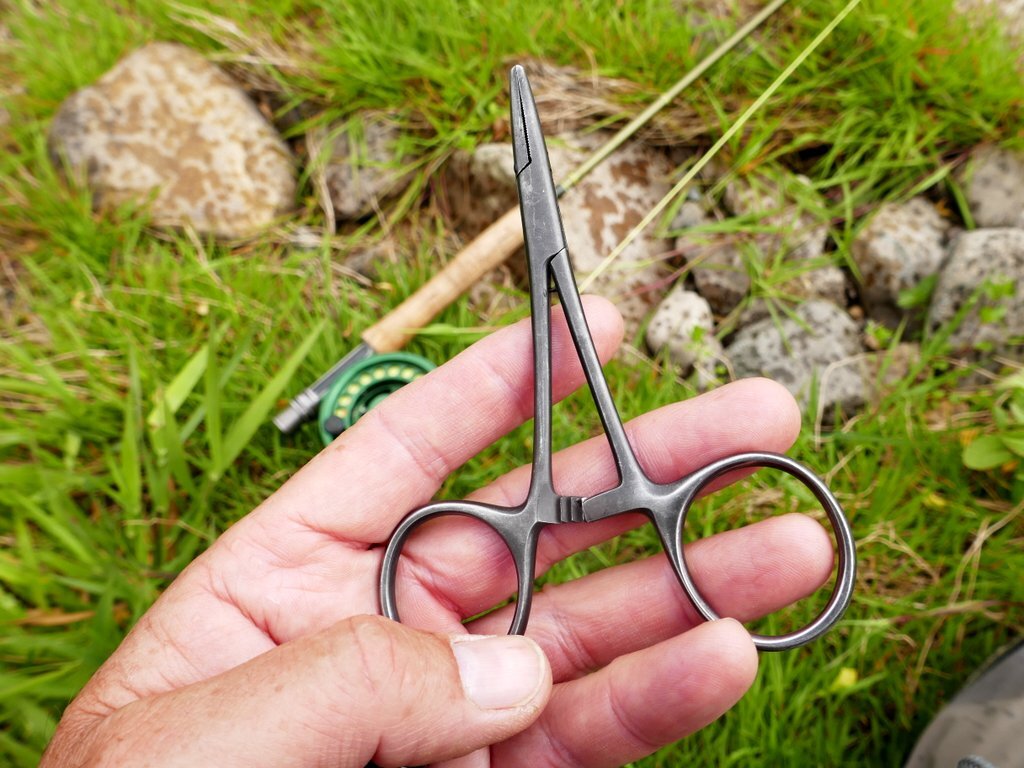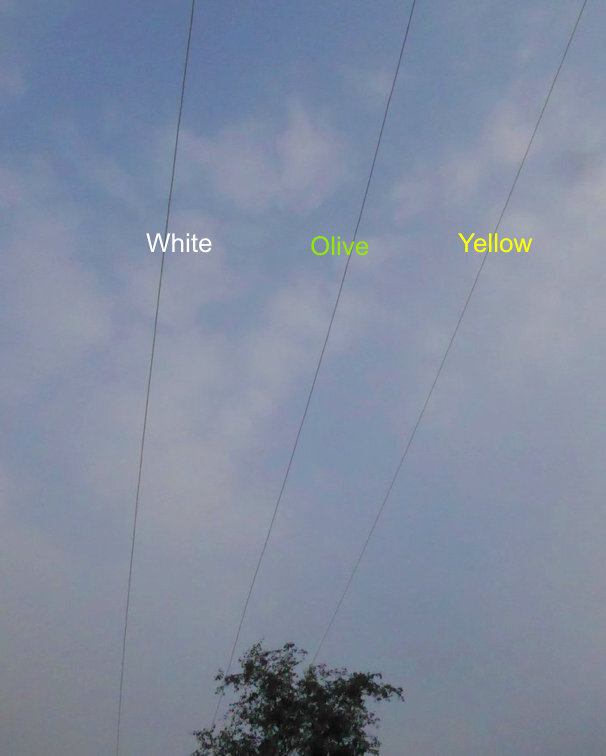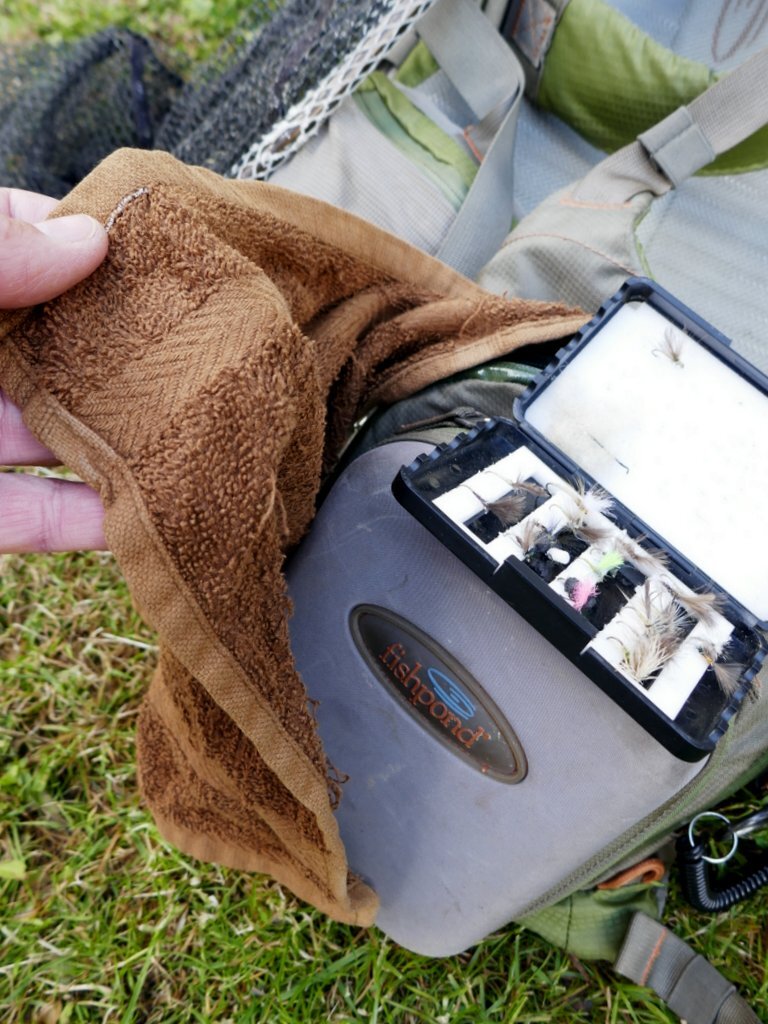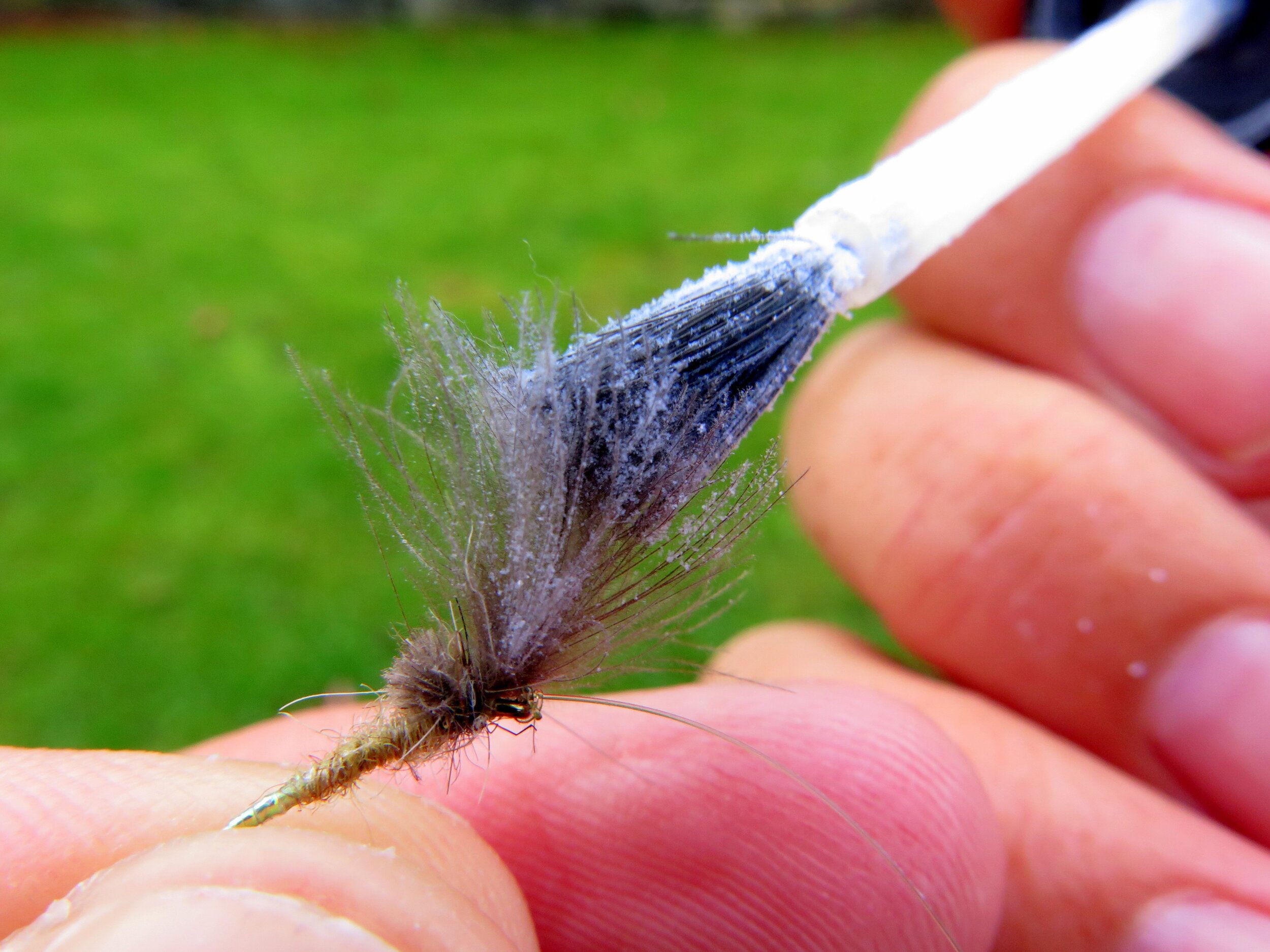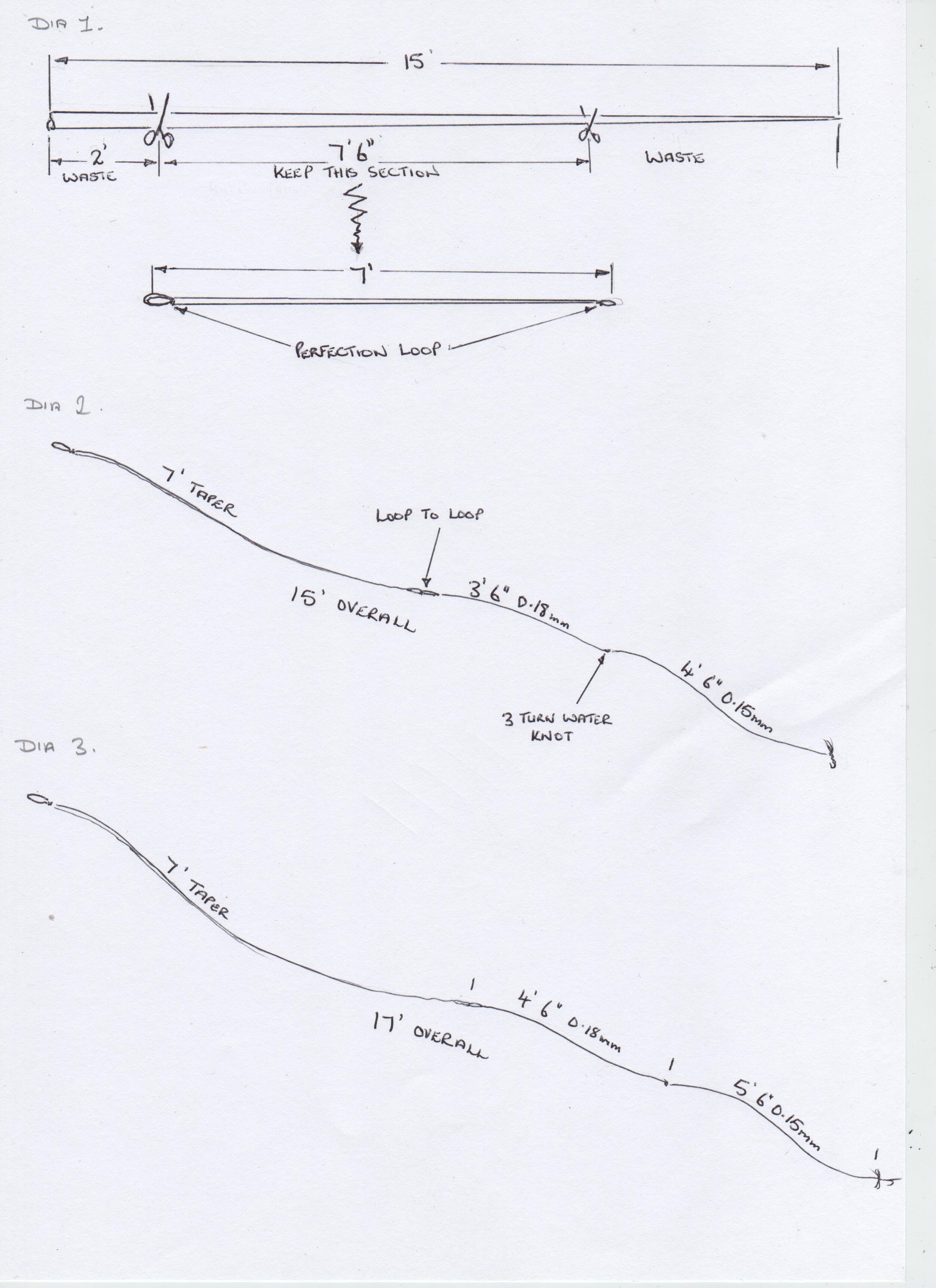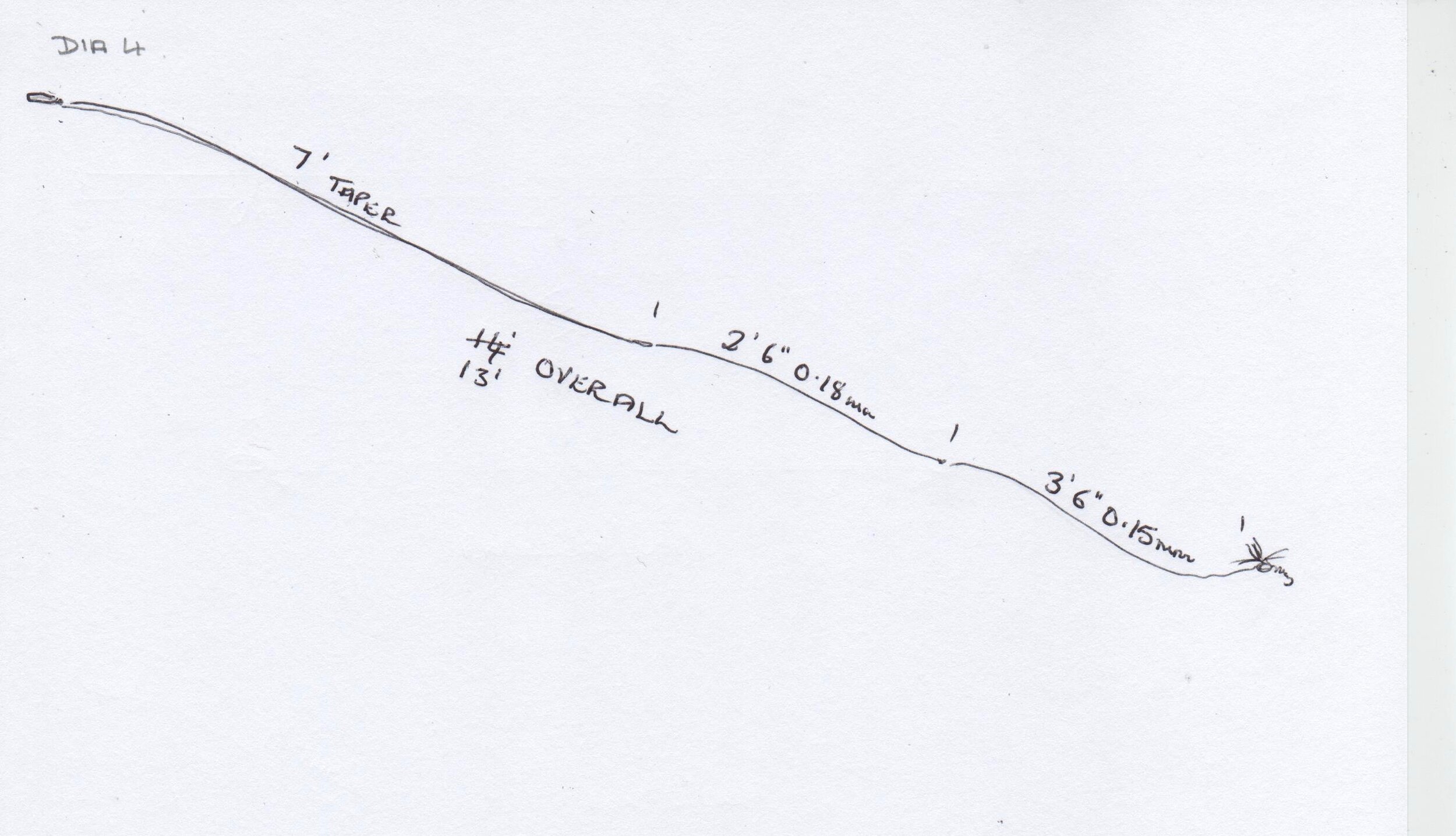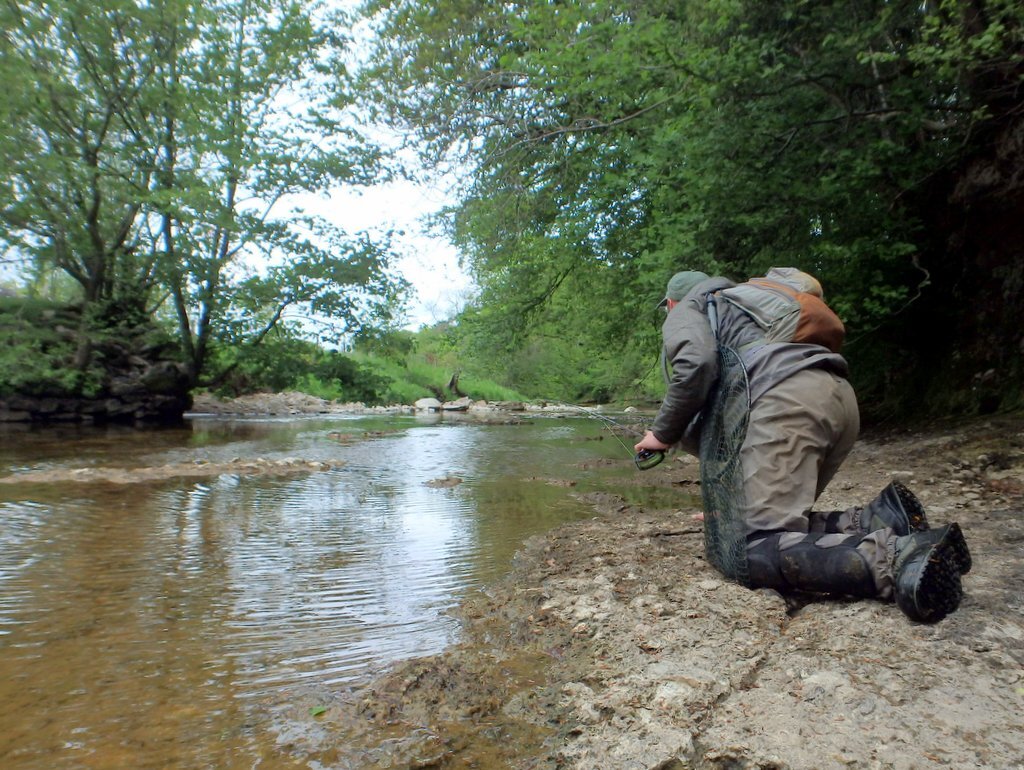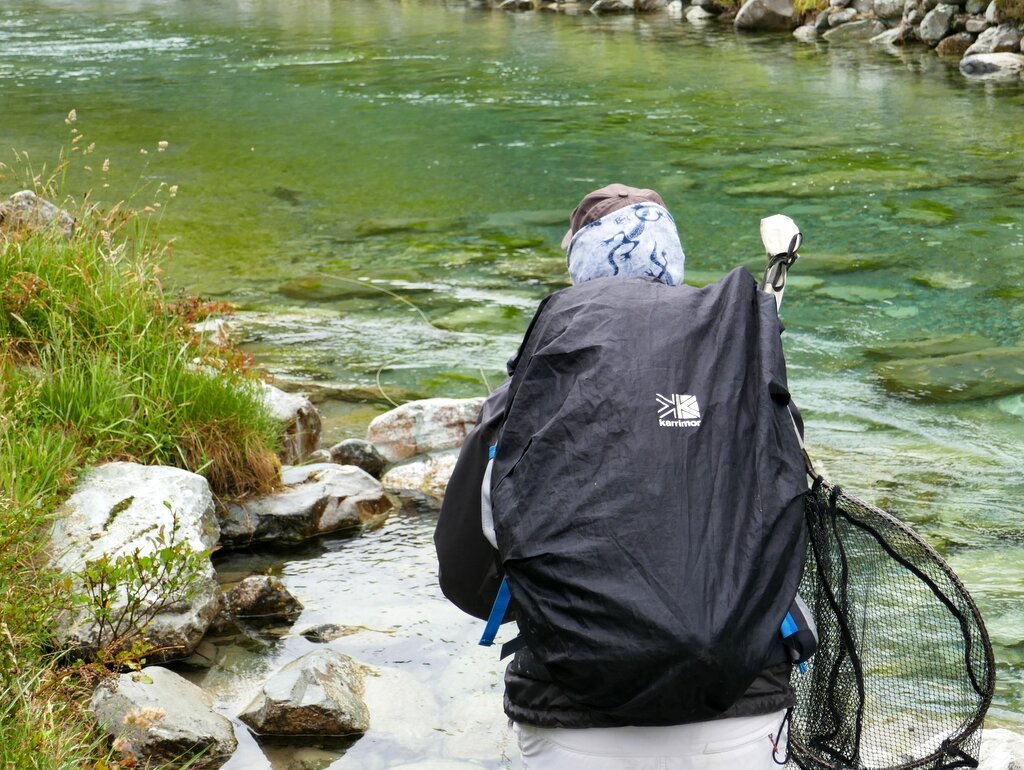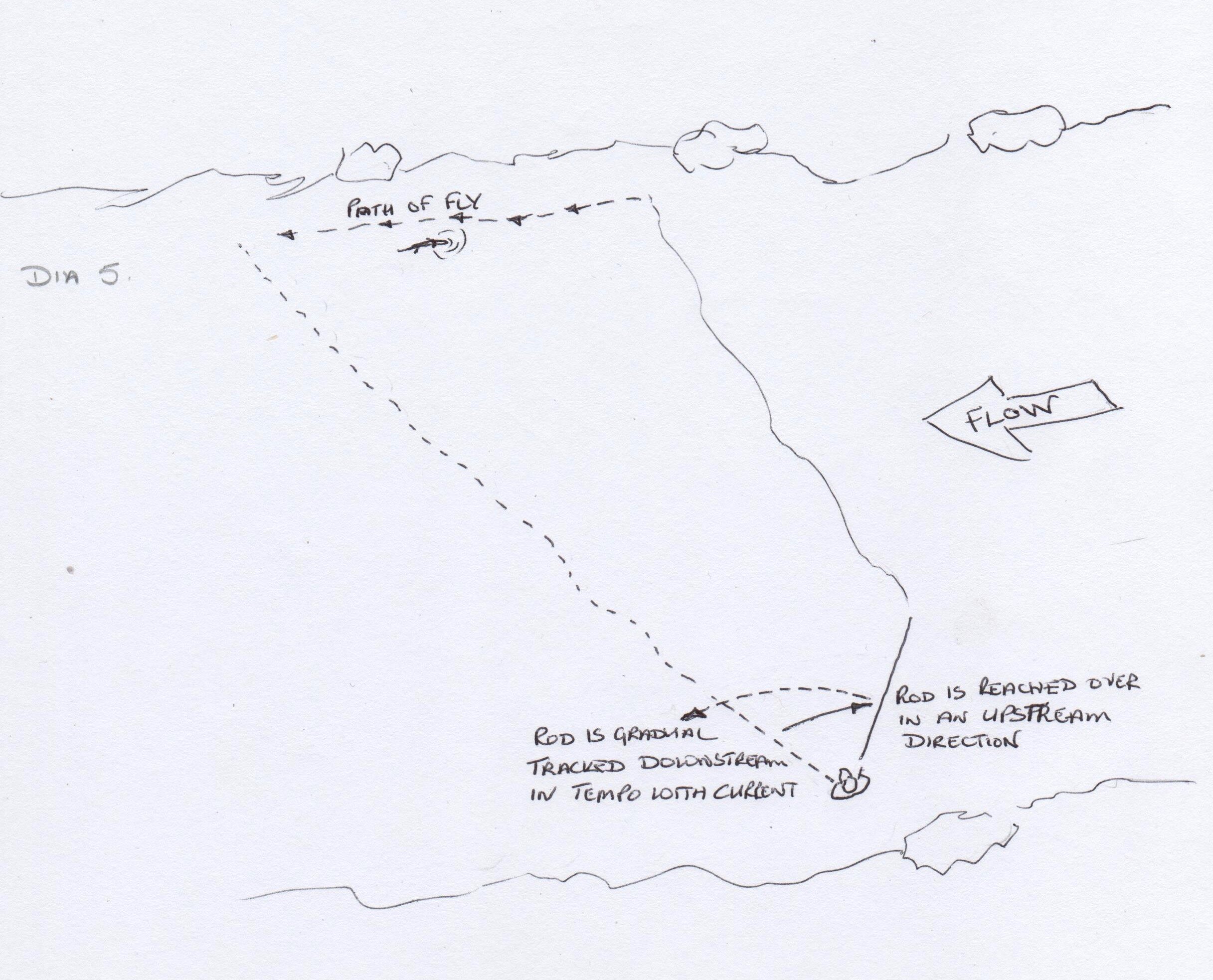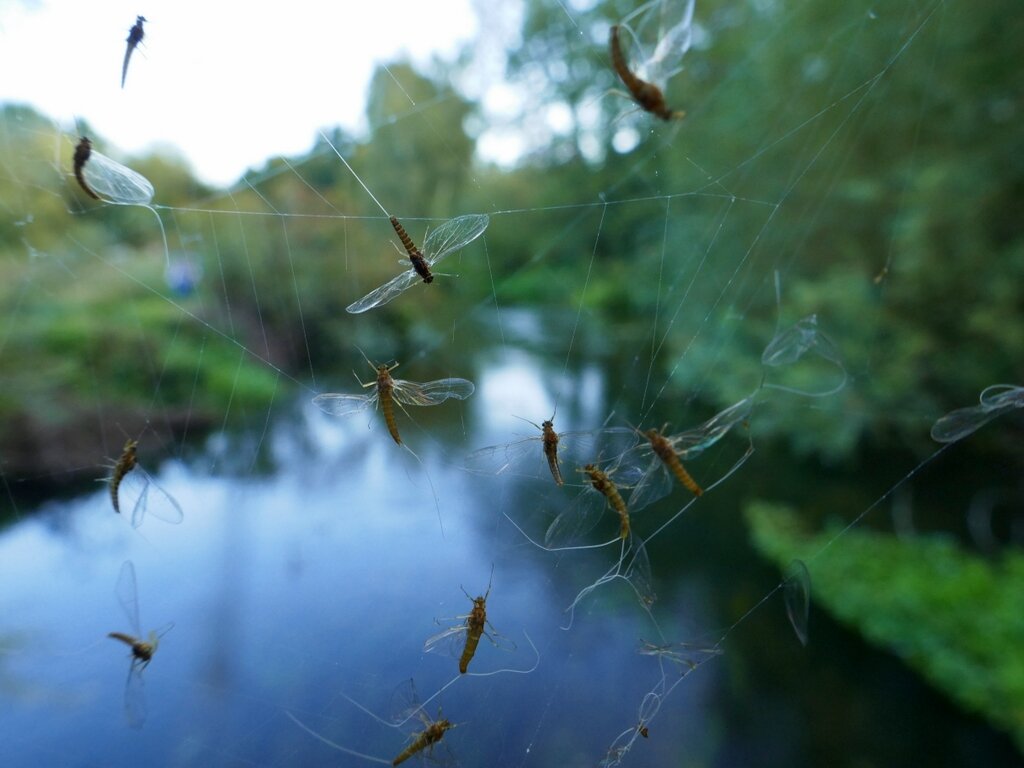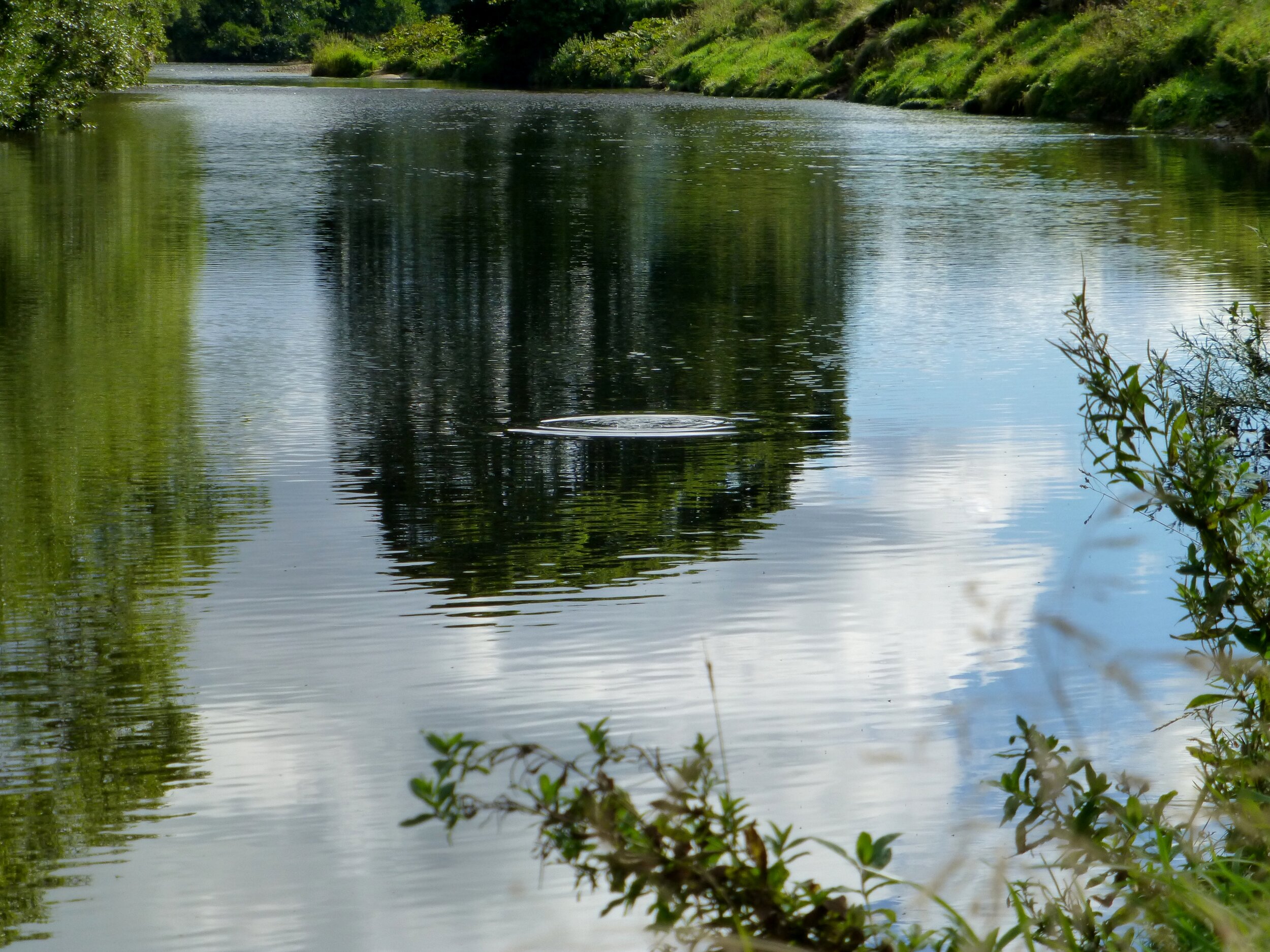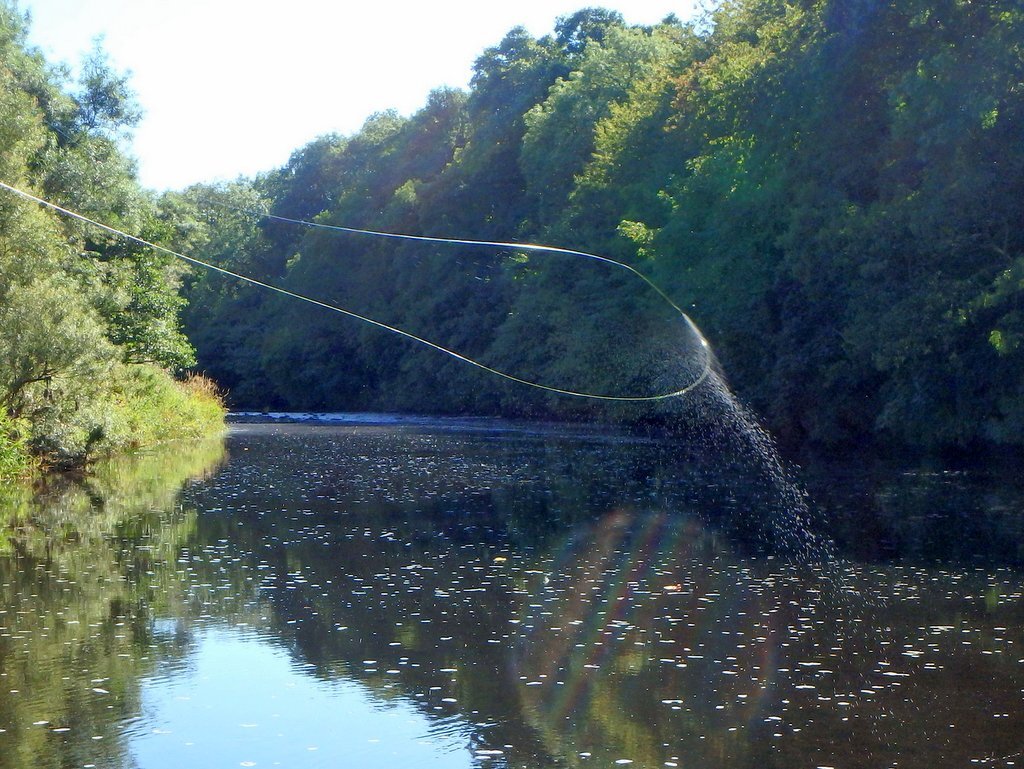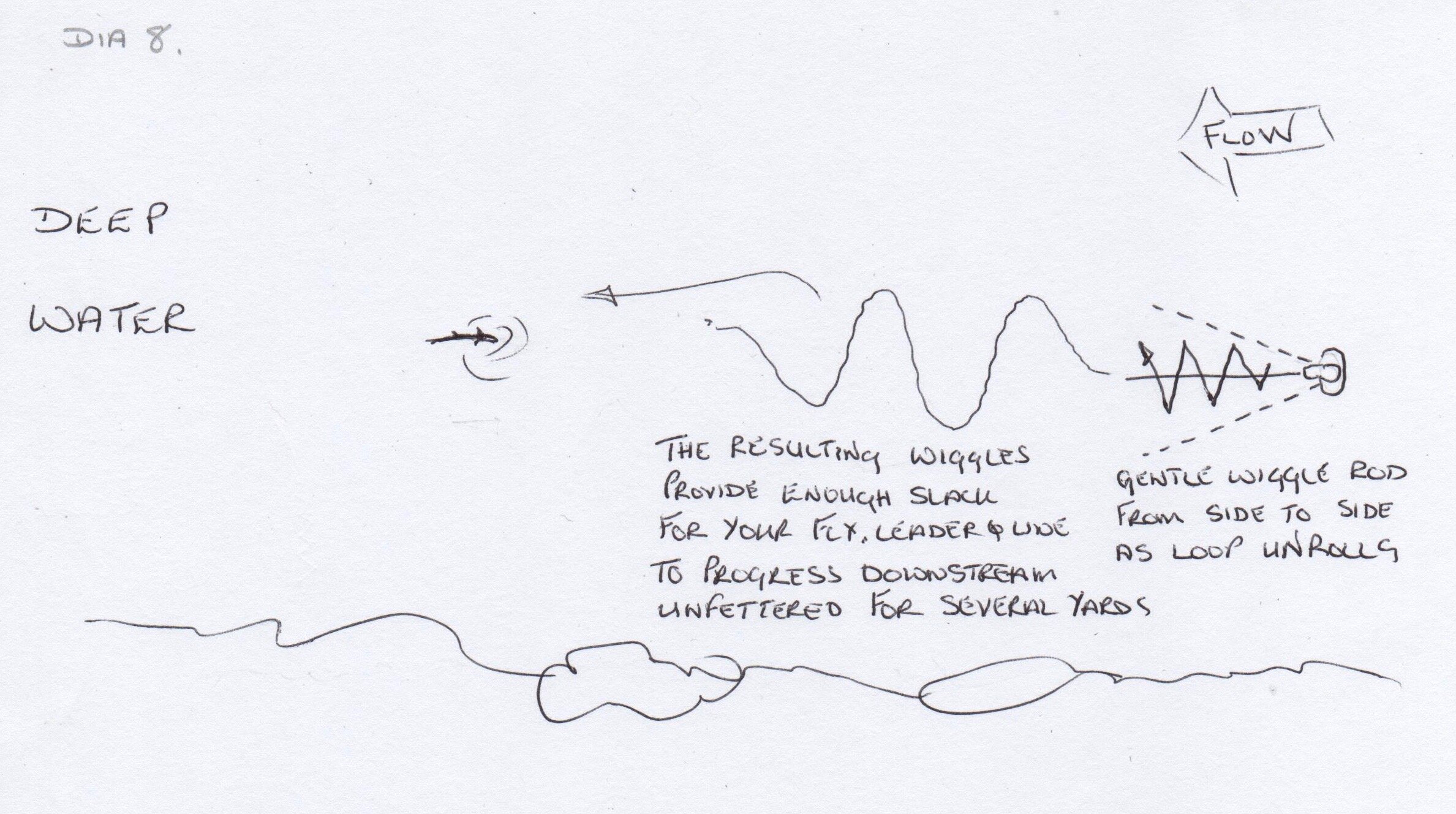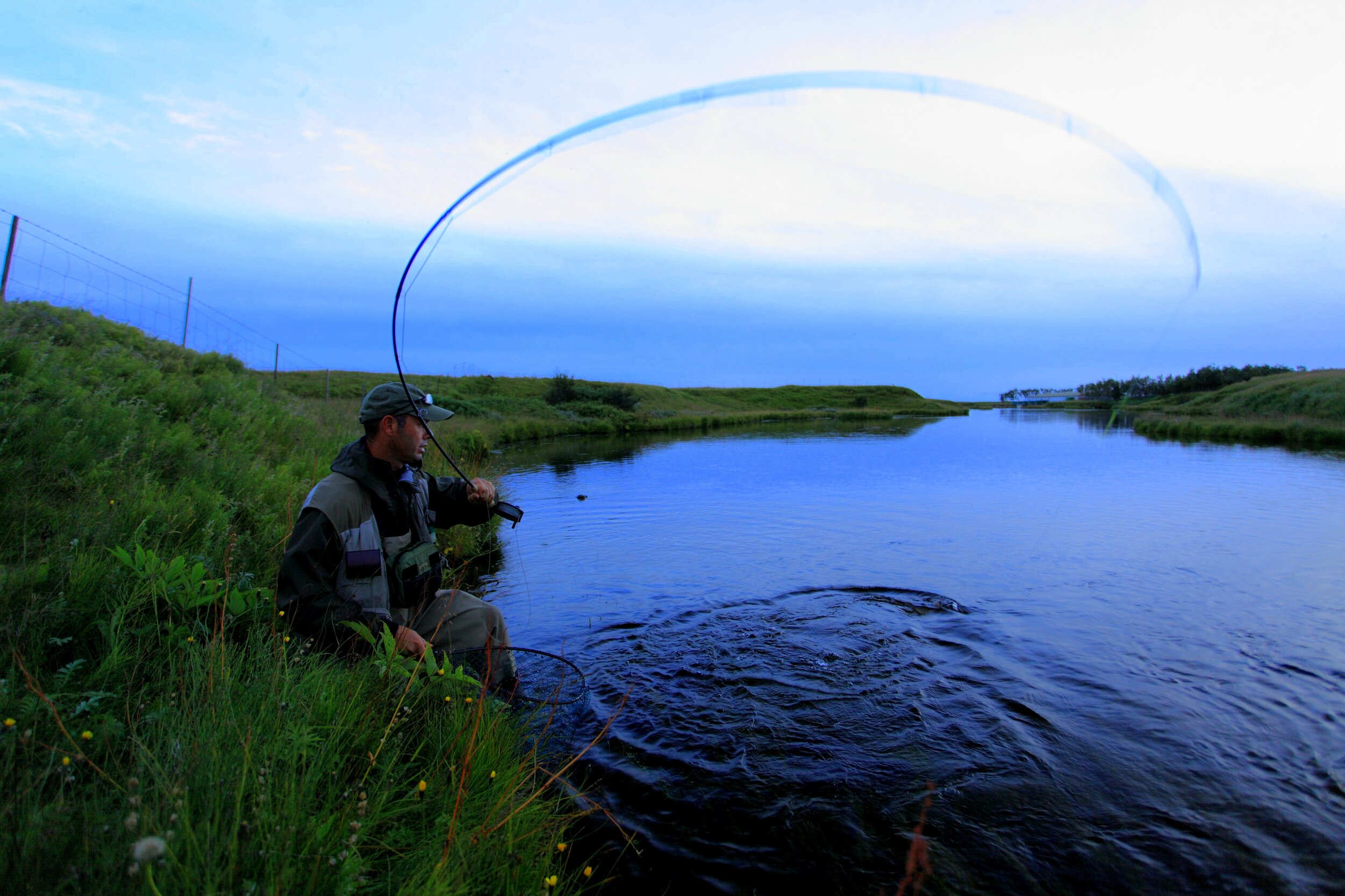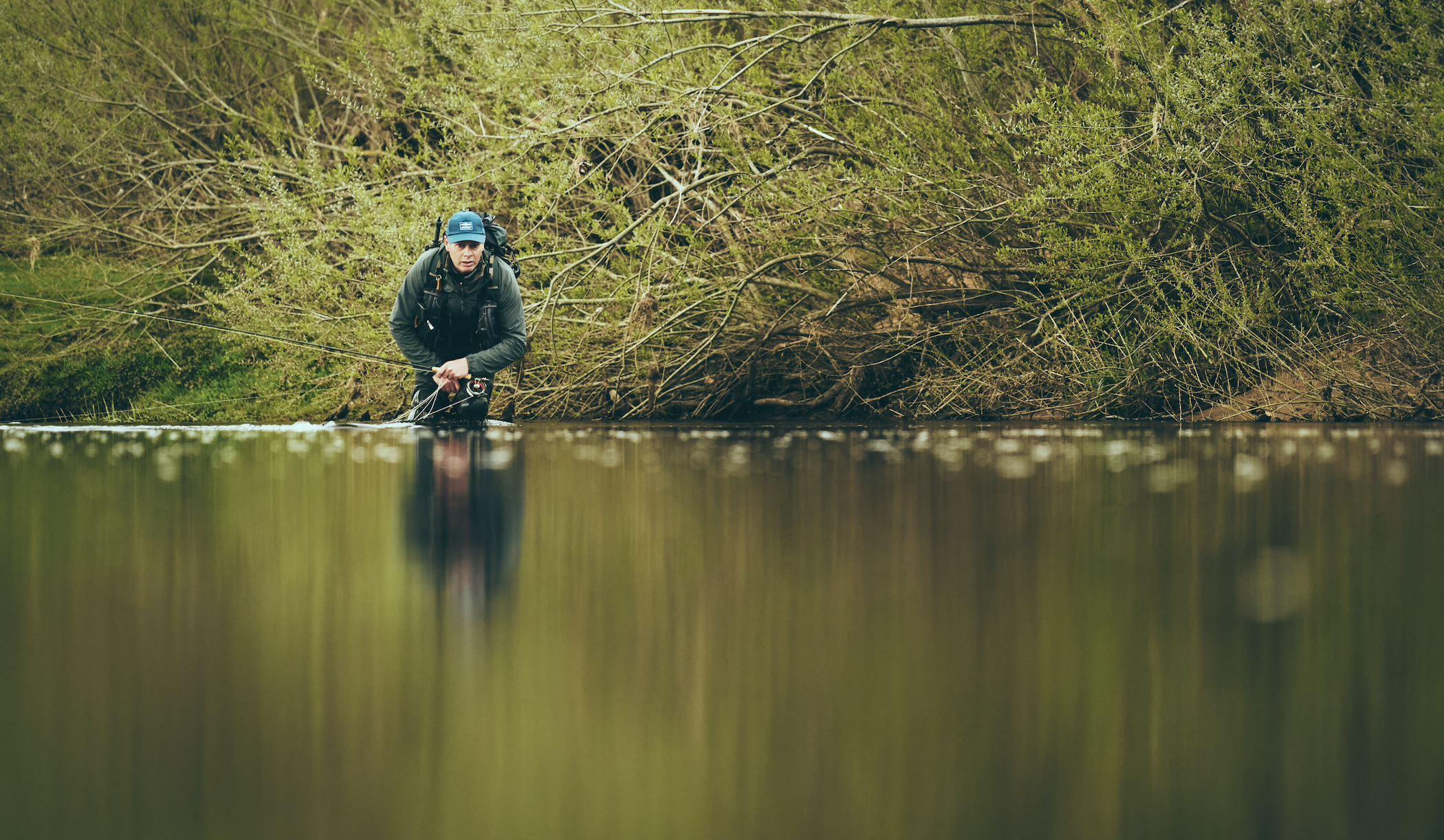
Paul Procter
Title Photo Alvaro G Santillan
1. Choice of equipment Rods, reels, fly lines, fly floatants, clothes, glasses and other useful items.
I’m very much a fan of longer rods and these days a medium action 10-footer is my ‘go to” weapon’. One rated for a 4-weight line offers enough finesse for low, clear water or where trout seem edgy though possesses enough grunt to cope with niggling headwinds and the throes of headstrong trout. I’m super paranoid about “flash” on equipment, right down to my forceps or snips, so prefer rods with a matt finish and non-reflective rod rings like the 10ft #4 Mackenzie NX1.
I’m very much an advocate of weight forward (WF) fly lines as modern day tapers are refined enough to land like thistledown. My reason is, when dry fly fishing on rivers, most casts rarely extend beyond 50ft and often far less. It’s a simple equation; let’s assume we are casting at a trout 50ft away using a 15ft leader. Deducting the 15ft leader and 10ft line still within the rod rings means we only aerialise 25ft of fly line. Even using short head WF lines, the head (belly) section will still be in the rod rings. This ultimately means WF lines behave more like double tapers, making them extremely stable during false casts.
Furthermore, often restricted room for back casts on rivers means we need to rely on shooting line on the final delivery, which is more easily achieved using a weight forward line. Finally, WF lines cope more easily with blustery head, or side winds.
I prefer more supple fly lines that gather up in limp coils when retrieving. Granted you might argue they create more line sag between rods rings that affects line shooting capabilities, but we’re not reaching for the horizon here. Bear in mind, biblical fly hatches often occur on chilly, damp days when frigid temperatures can make your fly line feel stiffer. Under such conditions an already wiry line simply becomes a nuisance.
Fly line colour is always going to be a contentious issue. I’m more your understated sort who plumbs for olive or grey lines. That said, there’s an argument that all fly lines at rest on water cast the same coloured shadow, namely a dark one. When viewed from below, fly lines all appear as a dark streak (Regardless of their colour, when viewed from beneath, all fly lines appear as a dark streak). The only argument I might make is, a conspicuous coloured line moving backwards and forwards during false casting might just catch the eye of a fish.
When it comes to reels, admittedly I prefer disc drag, which is purely for longevity in my eyes and not stopping power. Let’s be honest, most trout slog it out in their immediate domain and this is especially true of gnarly, old brown trout that insist on darting under tree roots, boulders and sunken logs rather than chancing a 100m sprint. One thing I insist on is a reel with a black, grey, or olive matt finish and not one of the blingy jobs that seem all the rage these days.
As mentioned, all my gadgets and fishing paraphernalia have a dull, non-reflective coating. As with rod, reel and line, the idea is to prevent any flash or glint, which could warn a trout all is not well in their world. Granted this sounds extreme but think how many times your attention is grabbed by the flash of another angler’s rod, reel, or shiny angling jewellery hanging from their vest!
For the same reason, I don clothing that blends into the environment with olives, browns and tans forming my fishing wardrobe. By the same token, I’ve never felt compelled to deck myself in camo gear from head to toe. The main thing is to blend in and move slowly with purpose rather than dash along the banks in a bid to get to the next perceived honey hole!
Decent polariods are a must in my book. For me Costa lenses are the best, though again, I avoid those mirror finish types popular amongst the saltwater fraternity. I reach for amber lenses on bright days with harsh light. Yellow lenses are reserved for cloudy weather or during more obscure conditions at dawn and dusk.
For revamping sodden dry flies a hand towel that costs 50p
A hand towel is ideal for revamping sodden dry flies has never let me down.
If CdC patterns are being used they are given a wee bit more care in the form of dry fly powder. I prefer to use a brush here to massage right into the root of CdC wings Dry fly powder should be massaged right into the root of any CdC wing
2. Leader material, build up, length and knots.
I’ve never been one for complex leader recipes that require tape measures and micrometers . Whilst these are straightforward to construct at home they’re a devil to replicate on the riverbank when a brutal downstream wind is buffeting you. So, at the risk of sounding agricultural, I keep dry fly leaders as simple as possible. By the same token I’m far from a conformist in regularly mixing nylon, copolymer and fluorocarbon on the same leader.
In essence, a 7ft tapered section cropped from a Leeda profil leader forms my datum (Dia 1) that’s attached using perfection loops. To this I add lengths of monofilament in various diameters. I’m rarely precious about exact measurements either. Leaders are touchy-feely affairs that require casting first on a given day to see how they behave. After all, turning over 20ft of flimsy leader in the teeth of a howling gale isn’t a walk in the park and something beyond most folk, including myself, so why make it difficult?
A reasonable starting point would be a 15ft leader that consists of the following; 7ft 6in Profil taper (nylon), 3ft 6in of 0.18mm dia (approx 7lb breaking strain) copolymer and a 4ft 6in tippet of 0.15mm (approx 5lb breaking strain) (Dia 2). Unless battling a headwind, I prefer a slightly longer tippet section. The idea being they flail a little more so land with a degree of slack which allows your fly extra freedom to drift unfettered.
To lengthen the leader by 1ft I’d simply increase the tippet section by 12in. However, if a 17ft overall leader was required; an extra 1ft of mono is added to both the tippet and next section up (Dia 3 ). To reduce the overall length to 14ft, a 12in section would be cut from the 0.18mm mono. If cropping back by 2ft, 12in would be snipped from each section (Dia 4 ).
Longer leaders are beneficial in low, clear water or when using smaller imitations. They’re also handy where complex currents exist; for example, in pocket water. Shorter leaders might be called for when a breeze gets up or when you’re in tight spots. They are simply easier to turn over with short, snappy casts.
Finally, a word on tippet diameters which are a trade off with regard to improved presentation versus strength. Obviously, finer connections allow our imitations the all-important ability to appear convincing, although they might not be optimal when dealing with headstrong fish. While sturdy tippets help you horse trout away from danger, their increased thickness shackles flies to some degree, therefore potentially causing unwanted drag. 0.15mm tippets might seem alarmingly thick to many, but much of my dry fly fishing revolves around larger trout on freestone rivers littered with snags. Admittedly, I do go finer but only following a refusal or two. Even then, 0.13mm is my cut off point.
3. Approach and stealth.
In my book, one of the most important aspects of fly fishing is your initial approach. After all, if fish are spooked prior to unlatching the fly you aren’t going to fool them no matter how sophisticated or expensive the tackle set up is.
Both prey and predator, wild trout are highly tuned creatures that constantly monitor their surroundings for subtle changes alerting them to possible danger. In this respect, it goes without saying, our approach should be both silent and unobtrusive.
To remain quiet my wading boots never have studded soles as these crunch under foot to potentially warn fish. This is especially true on drought-stricken streams where little ‘white noise’ exists due to lack of flows. Your footfalls ideally need to be delicate, pretty much like a leopard stalking its prey. Dislodging bank side stones and the likes as you creep up on a feeding fish only ends in tears! To that end, wading staffs are given a wide berth. I’ve seen too many clients wrestling with these clattering appendages when attempting to advance on rising fish.
When approaching trout, I habitually try to make myself as small as possible. This typically involves crouching or even edging forwards on hands and knees. For the sake of my knees and preventing wader punctures, a pair of knee/shin pads now rank high on my tackle list
Knee pads have become an essential tackle item for me
4. Reading the water.
The ability to read water when fly fishing ought to become second nature. That said, mapping out a river in your mind’s eye is an ever-evolving skill. We are naturally bound to rely on past experiences to point us in the right direction. Yet each time we visit a beat it is unique in every way due to prevailing conditions. Which brings to mind the famous saying “you never step in the same river twice”!
I am fortunate to fish more than most folk so I have quite a relaxed approach these days. Rather than dash in and start casting, I’m content to sit back and study a pool for several minutes and often longer. Naturally, my first scan of a pool is for rise forms, other disturbances or any signs of fly life that might encourage fish to stir.
I divide a section of water up on a priority scale, focussing mostly on places I’d expect to see a fish move or where trout are likely to lie. These include foam lanes (bubble lines), creases and seams caused by protruding boulders, or bankside obstructions and back eddies. My eyes constantly search out the demarcation lines between hard (broken) and soft (flat) water that indicates a sudden change in depth. Such places attract trout like bees to honey as they provide a curtain of popply water that trout are happy to feed under with the knowledge nearby inky depths offer an escape routes.
I often criss-cross water and watch a pool from either bank. Varying light angles offer a totally different perspective on the nature of water. Changing perspectives then help to identify certain features that may not have been obvious from the opposite bank.
5. Casting ability and which casts are essential.
In many respects, casting is a means to an end in that you don’t need to be a highly tuned casting instructor to catch fish. We frequently find ourselves in awkward situations when hunting wild trout using dry flies. These generally call for more unorthodox casts and manoeuvres to successfully get a fly in front of your chosen target.
That said, a better understanding and execution of a cast increases our odds of success. Those who fish pressured waters in places like New Zealand will be nodding knowingly by recalling the mantra “make that first cast count”. Risking generalisation, the more casts you end up making the more likely you’ll be rumbled. A smooth and slick style equates to less false casts when covering rise forms. Again, fewer movements reduce the chances of trout cottoning on.
Distance is rarely a necessity when river trouting as it’s normal to close the gap on fish by wading. This allows us to deliver our flies with a degree of control. Naturally, many casts are merely derived from the overhead discipline and some sort of slack line cast ought to be in your armoury. My favourite for introducing reasonable amounts of slack is the bounce cast.
The bounce cast is more dynamic versus other slack line deliveries that tend to be passive in nature. In a nutshell then even in breezy conditions the bounce cast has sufficient impetus to land on target while other slack line presentations are easily blown off course due to wider loops and more relaxed casting strokes or reduced line speeds.
Another essential is the reach cast that lays your fly line to one side or another when pitching at fish opposite your position. Not only does this facilitate longer drag free drifts by tracking your line with the rod in tempo with currents Dia 5, it also prevents your leader and/or fly line from landing over a trout’s head when you’re throwing at fish upstream of your position Dia 6.
6. Entomology, what should we know.
I put a huge emphasis on the understanding of bugs. It’s not so much to impress others with Latin names and the like, but to have a grasp on the fundamentals of what is occurring and what might be about to happen. Personally, I’ve taken this to another level purely because of my interests in trout fodder and growing conservation concerns in an ever deteriorating environment.
Basic entomology need be no more than recognising that trout are taking a particular fly at a specific stage. Hell, you don’t even have to identify them. As far as fish are concerned, it might be a wee olive jobbie that’s easily intercepted at the surface. Simply put, ‘entomology’ can be dressed up as observation. To that end, make a point of checking cobwebs in hedgerows, gateways, or nearby bridges during your short stroll to the river. These provide clues to help us make more informed fly choices once we reach the water’s edge.
( Spider’s webs provide vital clues, upwing (olive) spinners are likely to be on the menu.)
7. Rise Forms; Can they tell us something?
Rise forms tell us an awful lot. Firstly, they help determine the general size of a trout. Contrary to belief and as many seasoned anglers know, larger trout often rise with little fuss. If a notable trout moves quickly to intercept a morsel, its sheer mass displaces more water which may cause their intended surface target to be knocked off its path of travel a nano second before a trout aims to eat it. The upshot is the fish misses the food item, wasting precious energy into the bargain.
Studying a feeding fish for several minutes provides us with clues as to what it might be eating. Imagine its early season and the only flies hatching are large dark olives. You watch a procession of duns filter over a rising trout, yet it ignores them. By elimination, it is odds on this trout is nabbing emerging nymphs.
We’re often guilty of assuming fish rise religiously in the same spot time and again. However, on many occasions they traverse currents picking off flies. This is especially true during sparse hatches or falls of fly. Here we can determine how far a fish might swing to secure a meal. Such useful information translates as not having to land your fly directly upstream of a fish, but perhaps to one side by a couple of feet.
The regularity of a rise provides us with pointers when approaching fish. Trout rising like a metronome are so busy feeding that their guard is down more than usual allowing us to get in position unnoticed. Less frequent risers however are generally on high alert. In this case we need to be at the top of our game if we’re to succeed.
8. Fly selection, size, shape, materials, which flies are essential.
Dry fly fishing involves copying naturals, so it makes sense our imitations are of a similar size, shape and colour. That said, during blanket hatches our offerings can be lost amidst a sea of naturals. It’s beneficial our fly stands out now, by increasing its size. Colour too can be influential as the inclusion of conspicuous shades renders our flies more obvious, especially during low light or when water is murky.
Conversely there might be times when smaller artificials hold sway. Fish that take our fly and consequently missed, or those that snub flies, can be a sucker for a smaller, more delicate representations. To some degree more diminutive dressings work best on flat, smooth water while larger, scruffy effigies should be reserved for fast tumbling pools or where searching methods are relied on to pull trout up.
9. Presentation and drifts.
Casting is often parcelled up as ‘presentation’, yet, presentation is showing a fish a fly where it expects to see it and that behaves in a convincing manner. I was brought up on a diet of drag free drifts so your fly conforms to surrounding currents. This is usually very much the case, however there are times when a “worked” fly has more appeal.
Some years ago during a decent mayfly hatch on a wee Irish stream, trout were ignoring my studiously dead drifted mayfly dun. Having covered another fish without so much as a sniff, I began gathering in line to recast when a trout pounced on the partially skating fly. The penny dropped as watching rise forms after this encounter revealed fish singling out duns fluttering or wobbling at the surface. Subsequently, a gentle shake of the rod tip as my fly neared its target was enough to make it shudder and attract trout.
The same rings true where more energetic insects occur, like caddis fly for example. Immediately after emerging, in a bid to get airborne, winged adults often hop and skip across the surface. It doesn’t go unnoticed by trout when a fly that periodically wakes across water out-fishes more static patterns.
10. Upstream or downstream?
As a rule, most dry fly anglers progress upstream. First and possibly foremost, approaching fish from behind means you are seldom spotted by trout. Secondly, because our fly is thrown upstream, it drifts back towards us unfettered and therefore in a natural manner. However, casting directly upstream over the back of a fish is far from ideal. You’re better off at a slight angle (Dia 7) or using a reach cast mentioned above ( Dia 6).
Where circumstances allow, I generally position myself opposite a trout as from this position both accuracy and work rate remain super slick. Now, using a fixed, measured line the cast can’t be overshot, so it lands at exactly the same distance. Furthermore, once your fly passes the crucial spot by 3-4 ft it can be picked up and re-presented with little fuss. Whilst this could physically be done with a single casting cycle, its best to pick up and throw one false cast from where line was peeled off water. This serves to rid line, leader and fly of any residual moisture which if thrown directly over the head, or close to a rising trout serves to warn it all is not well.
There will be situations when flies presented downstream give us an edge. It might be that we’re unable to physically enter a pool immediately downstream of a fish. The obvious reasons being deep water or dangerous, powerful currents. Instead, position yourself upstream of a fish and use a wiggle cast to feed in either slack line so it gradually irons out (Dia 8). One huge advantage to delivering downstream is that fish invariably see the fly first.
( After pick up the initial false cast or two throws off residual spray, be sure to aim these casts to one side of a fish before your final delivery).
( After pick up the initial false cast or two throws off residual spray, be sure to aim these casts to one side of a fish before your final delivery).
11. Fighting fish.
Each fish we hook are unique in every single way, so fighting them is somewhat subjective. That said there are pointers to help us gain the upper hand. I’m very much for taking the fight to a fish rather than letting them have free rein. Where possible try keeping trout on a short leash as applying pressure and turning them is then more direct.
Of course, when initially hooked and therefore fresh, most trout make a mad dash. Rather than remaining static, I follow them whilst reeling in line. A vertical rod at this stage holds line out of the water reducing pressure and preventing any sunken fly line from being wrapped around snags by belligerent trout.
Once that first electrifying run is over, I close in and apply side strain by angling my rod in a horizontal plane. This really does exert more pressure on trout and ultimately helps you steer them away from danger. For example, a fish bolting to the left should be countered by you swinging the rod to your right and vice versa.
This action often causes trout to twist, then turn and such energy expenditure will tire them sooner. As they become more disorientated now, fish are netted far more quickly than if you leave them to tow you around a pool.
Netting fish, especially prize ones, is perhaps the most crucial stage. With hardly any line outside the rod tip there is barely any stretch in our system. Now, a vertical rod results in only the tip coming into play thereby reducing unnecessary pressure and guarding against any last-minute violent head shakes from a disgruntled fish. Finally, where possible guide fish into the net headfirst as the trout’s body will always follow it head and, of course conveniently for us, fish don’t have a reverse gear!
Side strain is a great way to apply pressure and help steer trout away from dangerous snags
